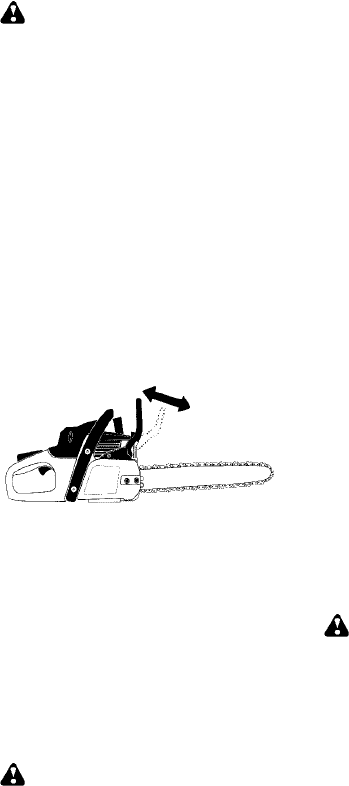
11
Starting could require pulling the starter rope
handle many times depending on how badly
theunit isflooded. Ifenginefails tostart, refer
to the TROUBLESHOOTING TABLE or call
1-800-554-6723.
CHAIN BRAKE
WARNING: If the brakeband isworn
too thin it may break when thechain brake is
triggered. With a broken brake band, the
chain brake will notstop thechain. Thechain
brake should be replaced by an authorized
service dealer if any part is worn to less than
0.020″ (0.5 mm) thick. Repairs on a chain
brake should be made by an authorized ser-
vicedealer .Take your unittotheplace ofpur-
chase if purchased from a servicing dealer,
or to the nearest authorized master service
dealer.
S This saw is equipped with a chain brake.
The brake is designed to stop the chain if
kickback occurs.
S The inertia--activated chain brake is
activated if the front hand guard is pushed
forward, either manually (by hand) or
automatically (by sudden movement).
S If the brake is already activated, it is
disengaged by pullingthefront handguard
back toward the front handle as far as
possible.
S When cutting with thesaw,thechainbrake
must be disengaged.
Engaged
Disengaged
Braking function control
CAUTION:
The chain brake must be
checked several times daily. The engine
must berunning whenperforming thisproce-
dure. This is the only instance when thesaw
should be placed on the ground with the en-
gine running.
Place the saw on firm ground. Grip the rear
handlewithyourrighthand andthe fronthan-
dle with your left hand. Apply full throttle by
fully depressing the throttle trigger . Activate
the chain brake by turning your left wrist
against the hand guard without releasing
your grip around the front handle. The chain
should stop immediately.
Inertia activating function control
WARNING: When performing the
following procedure, the engine must be
turned off.
Grip the rear handle with your right hand and
the front handle with your left hand. Hold the
chain saw approximately 14″ (35 cm) above a
stump or other wooden surface. Release your
grip on the front handle and use the weight of
the saw to let the tip ofthe guide bar fall forward
and contact the stump. When the tip of the bar
hits the stump, the brake should activate.
OPERATING TIPS
S Check chain tension before first use, after
1 minute of operation, and each time be-
fore you start the chain saw. See CHAIN
TENSION in the ASSEMBLY section.
S Cut wood only. Do not cut metal, plastics,
masonry , non-wood b uildi ng materials, etc.
S Stop the saw if the chain strikes a foreign
object. Inspect the saw and repair or re-
place parts as necessary. If the chain
jumps off the guide bar, inspect the chain
for damageddrivelinks beforereinstalling.
Burrs on drive links, which prevent them
from entering the groove of the guide bar,
can be removed with a flat file.
S Keep the chain out of dirt and sand. Even a
small amount of dirt will dull a chain, increase
the possibility of kickback, and require chain
sharpening or replacement.
S Practice cutting a few small logs using the
following techniques to get the“feel” of us-
ing your saw before you begin a major
sawing operation.
S Squeeze the throttle trigger and allow the
engine to reach full speed before cutting.
S Begin cutting with the saw frame
against the log.
S Keep the engine at full speed the entire
time you are cutting.
S Allowthechaintocutfor you. Exertonly
light downward pressure. If you force
the cut, damageto thebar,chain, oren-
gine can result.
S Release the throttle trigger as soon as
the cut is completed, allowing the en-
gine to idle. If you run the saw at full
throttle without acutting load,unneces-
sary wear can occur to the chain, bar,
and engine. It is recommended that
the engine not be operated for lon-
ger than 30 seconds at full throttle.
S To avoid losing control when cut is com-
plete, do not put pressure on saw at end
of cut.
S Stop the engine before setting the saw
down after cutting.
TREE FELLING TECHNIQUES
WARNING: Check for broken or dead
branches which can fall while cutting causing
serious injury. Do not cut near buildings or
electrical wires if you do not know the direction
of tree fall, nor cut at night since you will not be
ale to see well, nor during bad weather such as
rain, snow , or strong winds, etc. I f the tree
makes contact with any utility line, the utility
company should be notified immediately .
S Carefully planyour sawingoperation inad-
vance.
S Clear thework area. Youneeda cleararea
allaround thetree so youcan have secure
footing.
S The chain saw operator should keep on
the uphill side of the terrain as the tree is
likely torollor slidedownhill afterit isfelled.
S Study the natural conditions that can cause
the tree to fall in a particular direction.
Natural conditions that can cause a tree to
fall in a particular direction include:


















